The Brits do love their steamed puddings, from the Christmas “figgy pudding” to all kinds of sweet and savory renditions. After making this persimmon steamed pudding, I echo their pudding love. It was delicious, and doesn’t require specialized equipment. Most of the “time” is down time while it is steaming away.
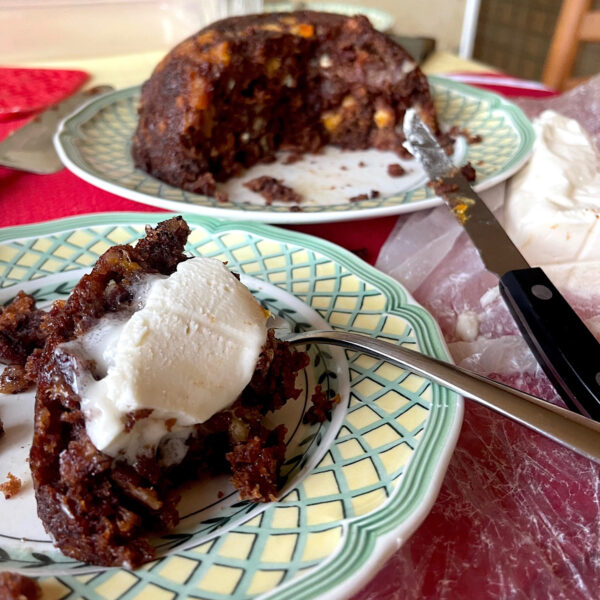
Jump to: RECIPE | What is a Steamed Pudding? | The ”Molds” | Illustrated Step by Step | How to Steam | Removing the Pudding from the Mold | FAQs
This post may contain affiliate links, and you can read our disclosure information here–
What is a Steamed Pudding?
The Brits definition of “pudding” isn’t the same as an American one for sure. American puddings are similar to custards with a soft, creamy texture.
The British definition of a “sweet English pudding“ can include any number of desserts. It is generically referred to as the sweet ending to a meal (aka dessert in the US).
A steamed pudding however, is a little more specific. It can be savory or sweet, and it is boiled or steamed in some sort of container.
The sweet steamed puddings are generally steamed in a “pudding mold”, but the savory puddings might be steamed in cloth or an animal intestine. Yeah, well….
The traditional sweet steamed puddings are super rich and have the texture of a moist cake or quick bread. Think zucchini bread for texture and chocolate cake for richness.
Most Americans think of figgy pudding or plum pudding when referring to the classic English pudding, perhaps because of the words in a popular Christmas carol, but many different fruits can be part of a steamed pudding.
Ingredients for Persimmon Steamed Pudding
In the recipe below we used fresh persimmons and the flavor and texture was excellent. Here are the ingredients used in this particular recipe:

What to Use for a Pudding Mold
Old fashioned pudding molds look like a bundt pan with a lid, sometimes with a handle on top to pull it out of the steamer pot.
Pudding molds are not that easy to find however, and many people will only use them once a year. I find a bundt pan covered tightly with aluminum foil worked just fine. For this post I used a glass mixing bowl.

If you want to get very fancy for a holiday gathering, you might be able to find some more elaborate molds with intricate carvings on them, but they are fairly difficult to find.
Some of the bundt pans can be intricate but they don’t come with a lid. It’s not really a problem to place aluminum foil over the bundt pan, but if you want a mold with a lid, this is the standard mold for steamed puddings.
The Steaming Process made Easy
Steamed puddings have fallen out of favor, primarily because the process appeared difficult and the equipment was specialized. Neither of these needs be the case.
The steaming process is hands off and quite easy, and the equipment can be as simple as a bundt pan or a medium to small glass or ceramic mixing bowl, some foil and a large pot with a metal trivet to place in the bottom of the pot.
Basically it is like making a cake from scratch, pouring the batter into some sort of mold, covering the mold tightly with foil and placing the mold in a large covered pot filled 2/3 of the way up the mold with water.
The rest of it is just letting it steam away on the stove for several hours, checking to make sure the water hasn’t evaporated every 1/2 hour or so.
Illustrated Step by Step
Here are the steps lined out with photos. For the details of the recipe itself, see the recipe card below.
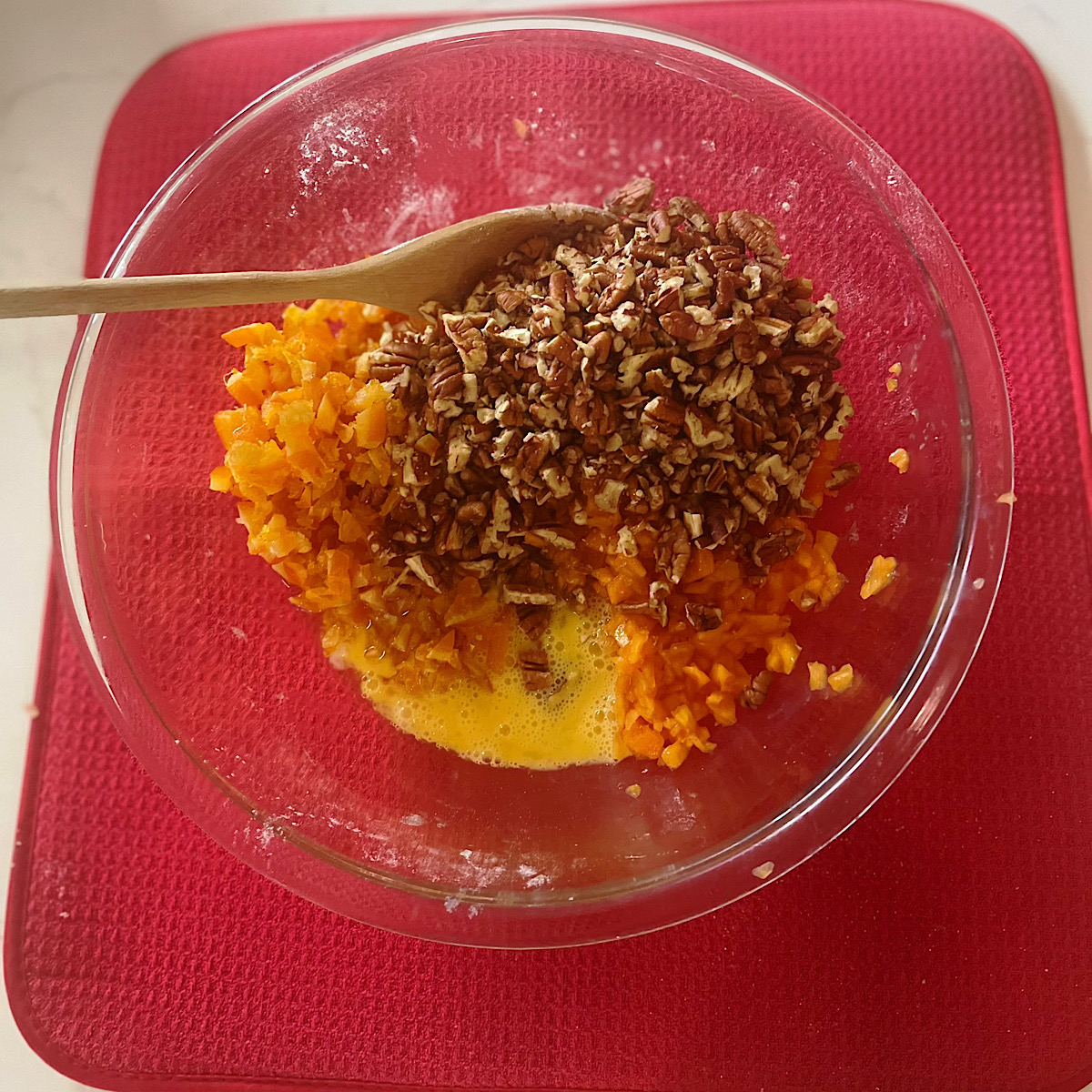
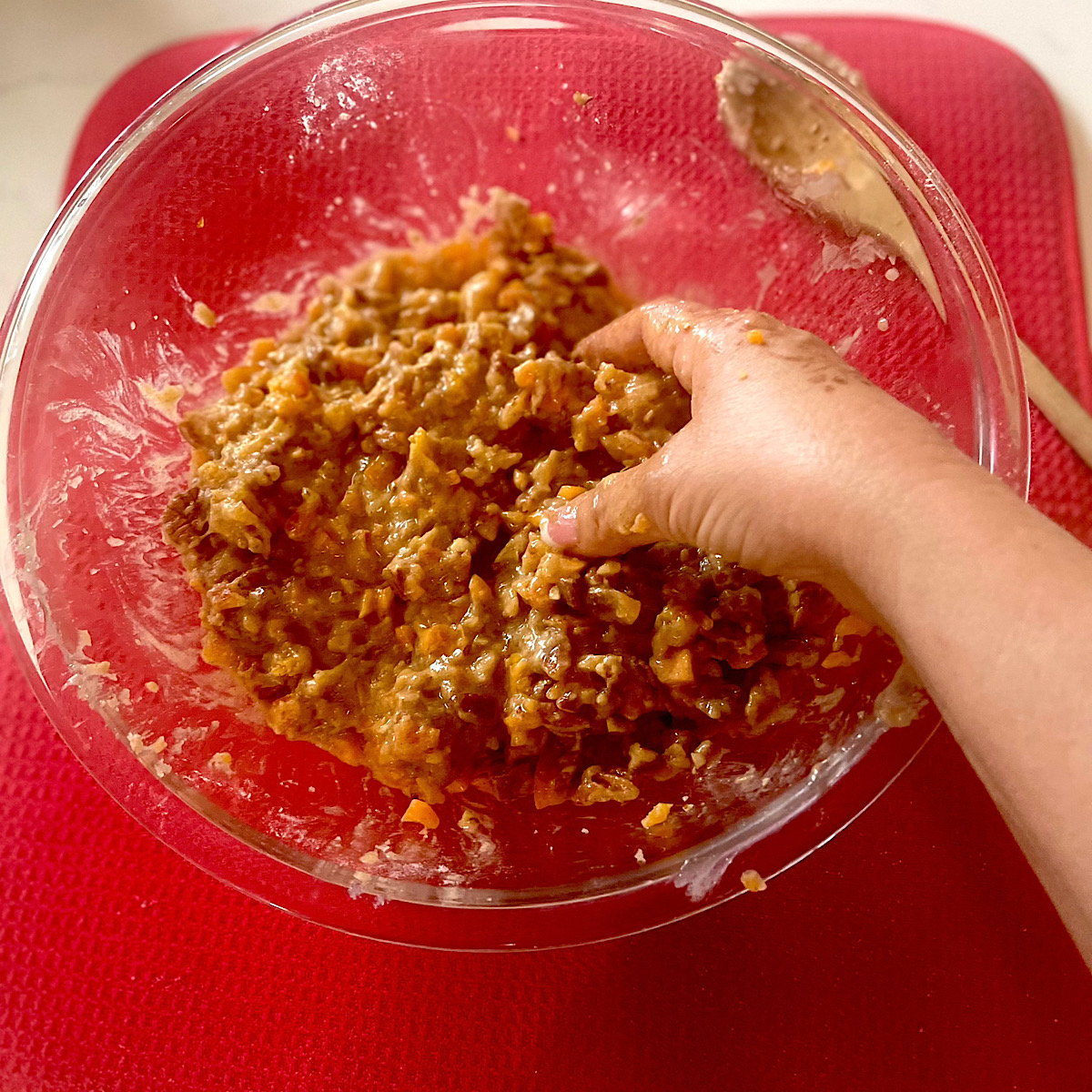
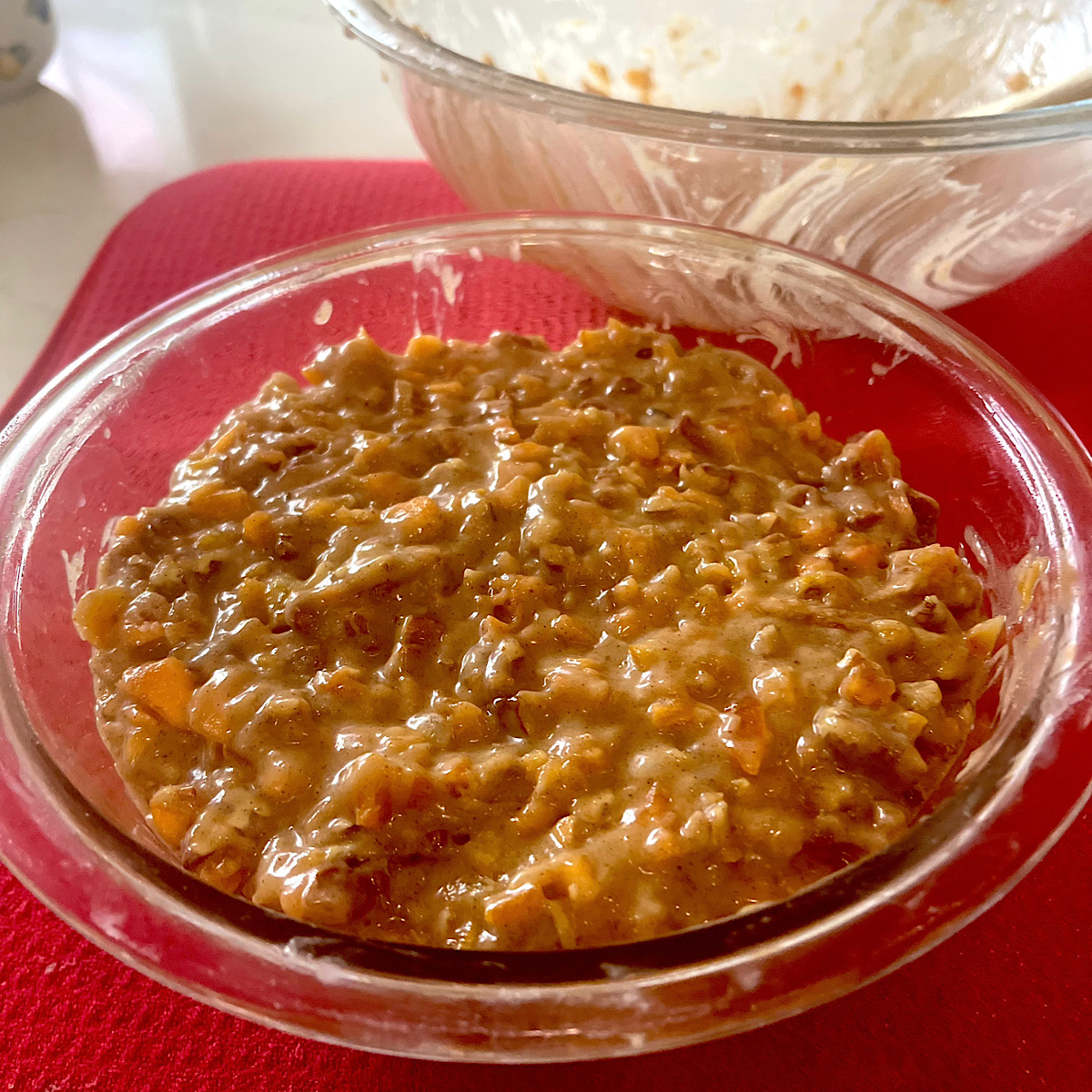
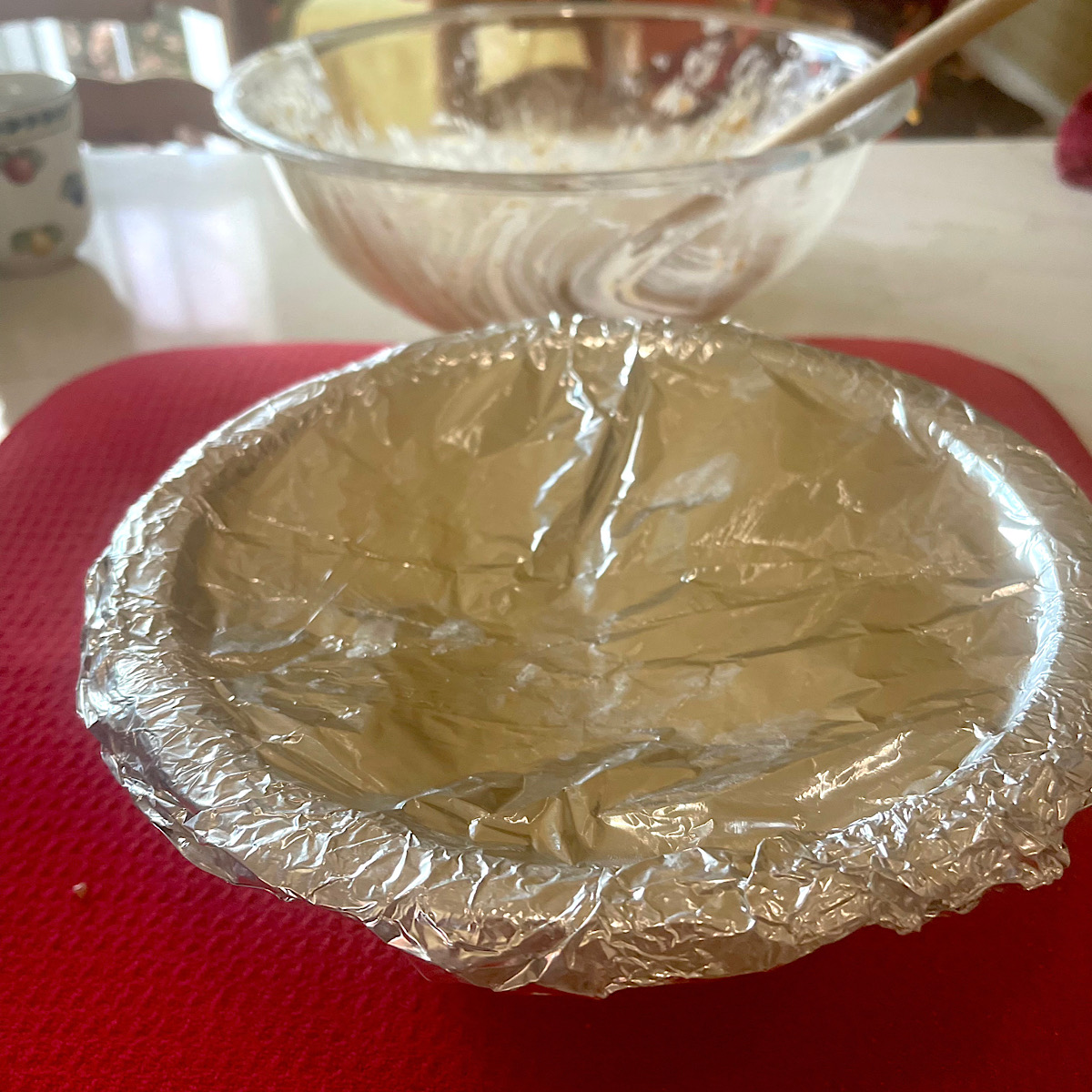
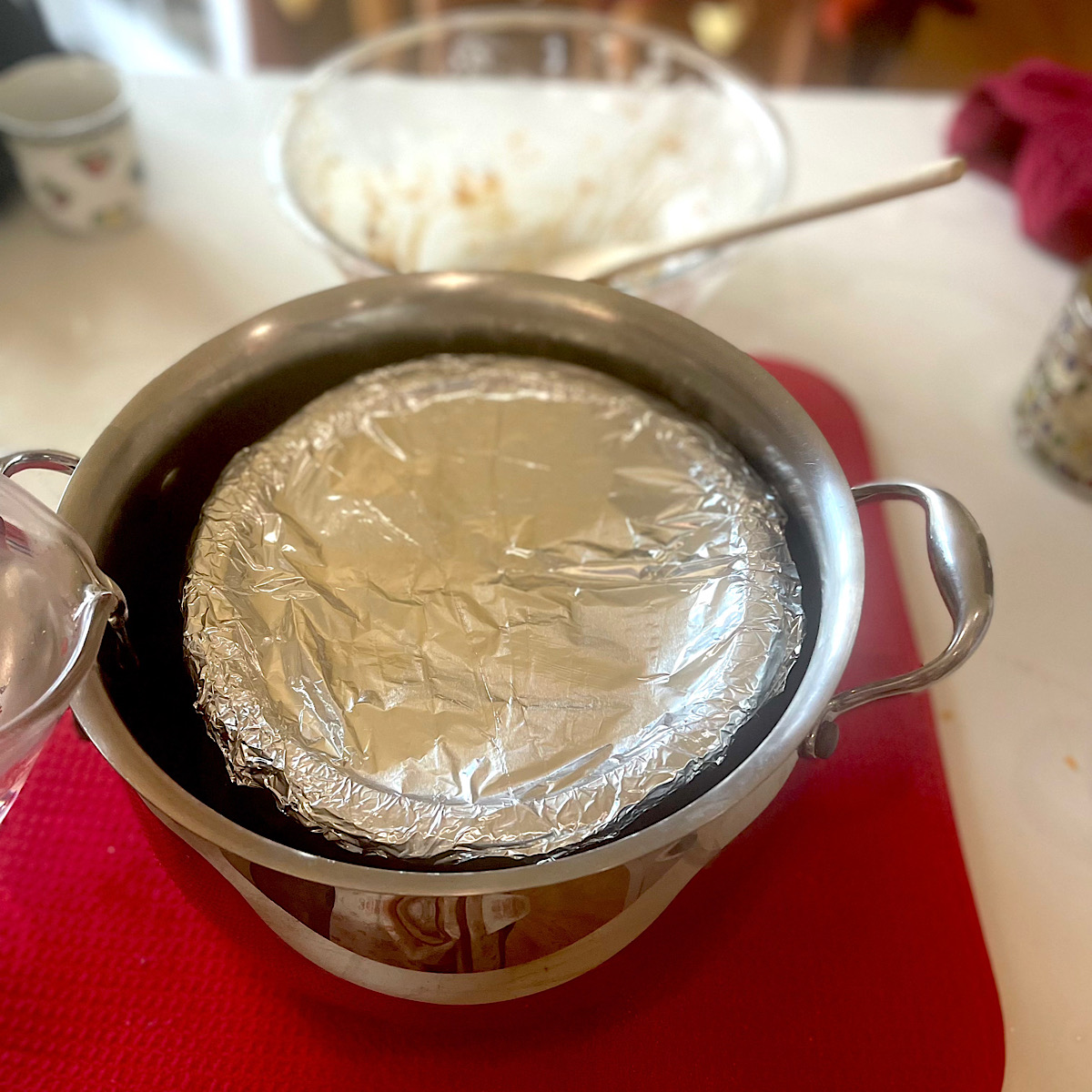
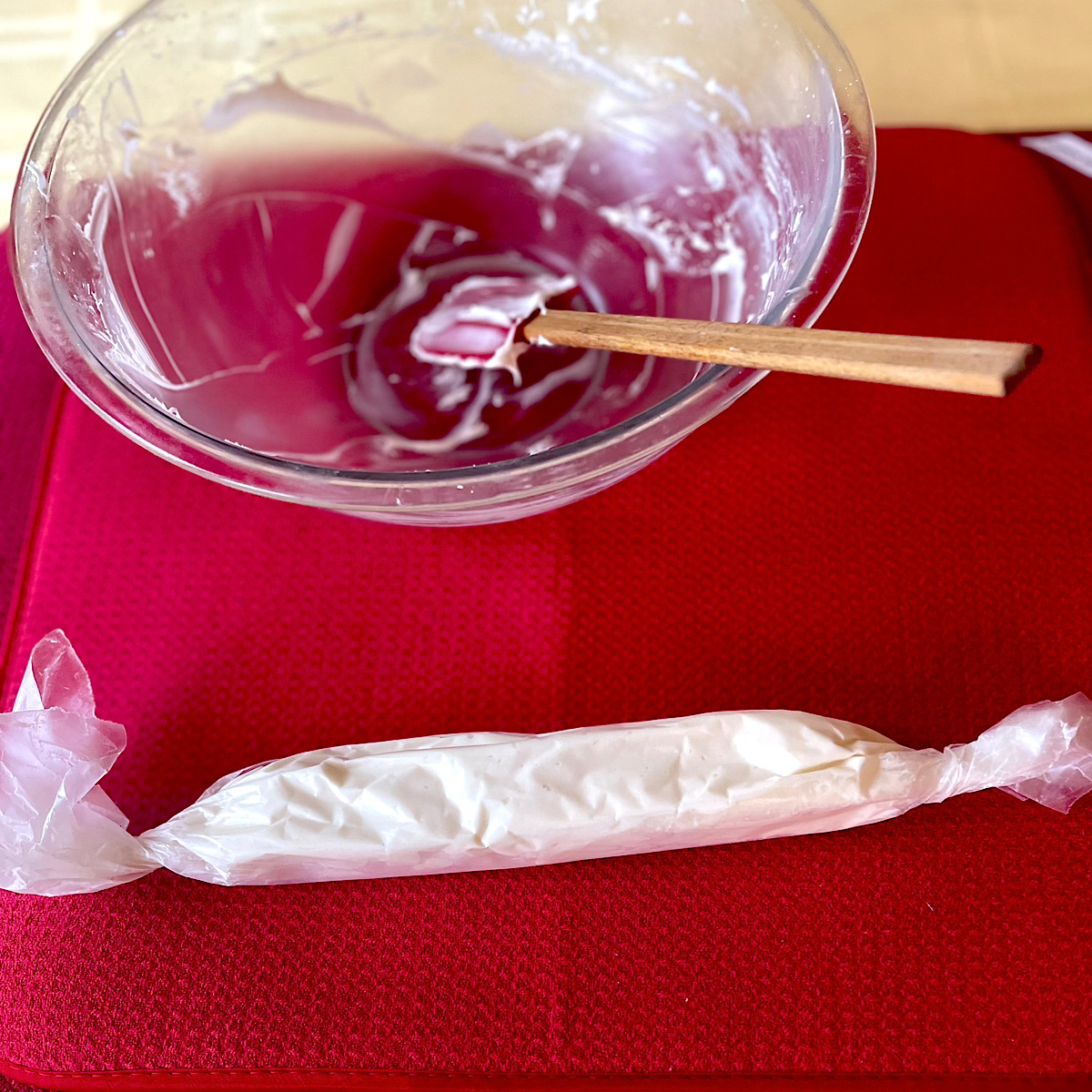
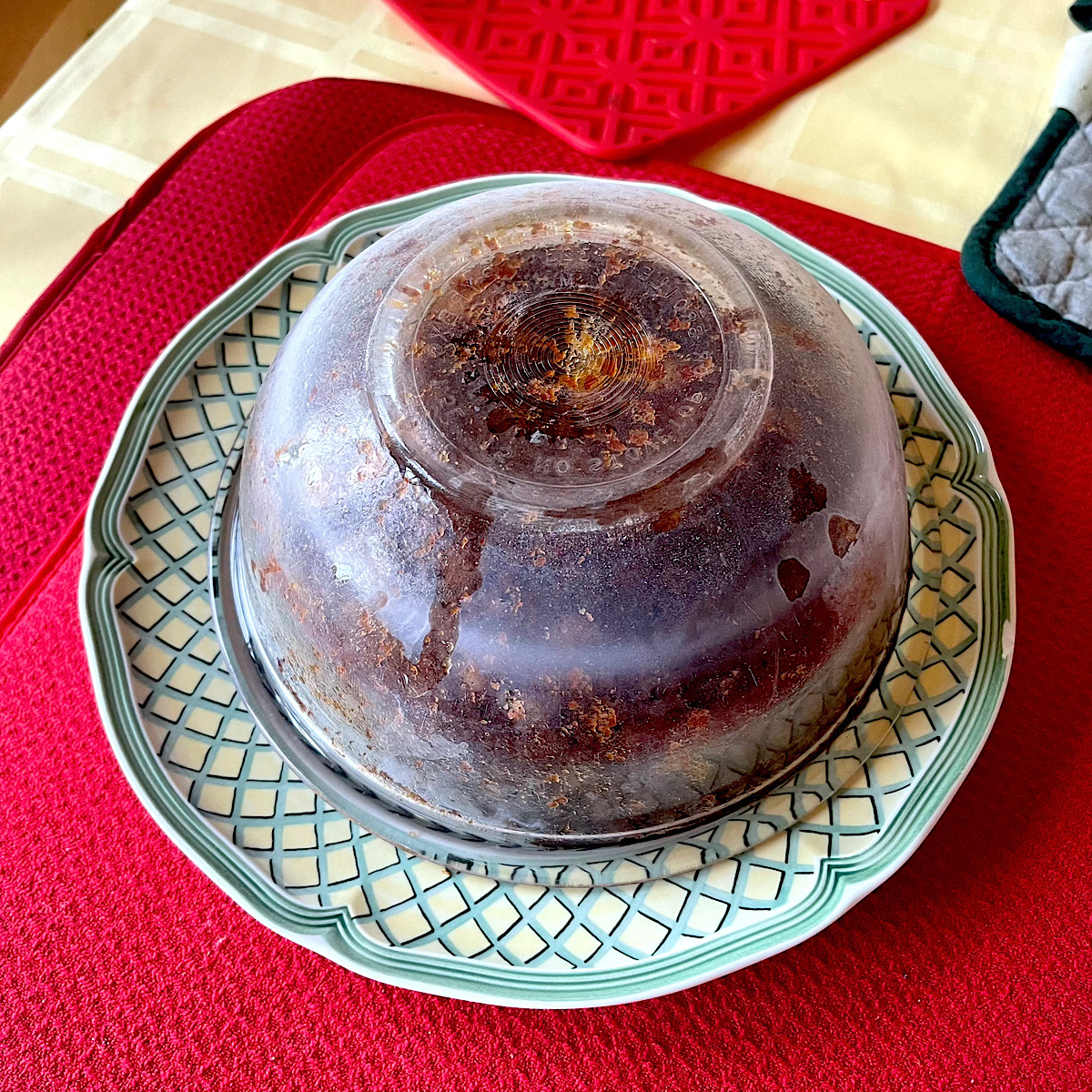
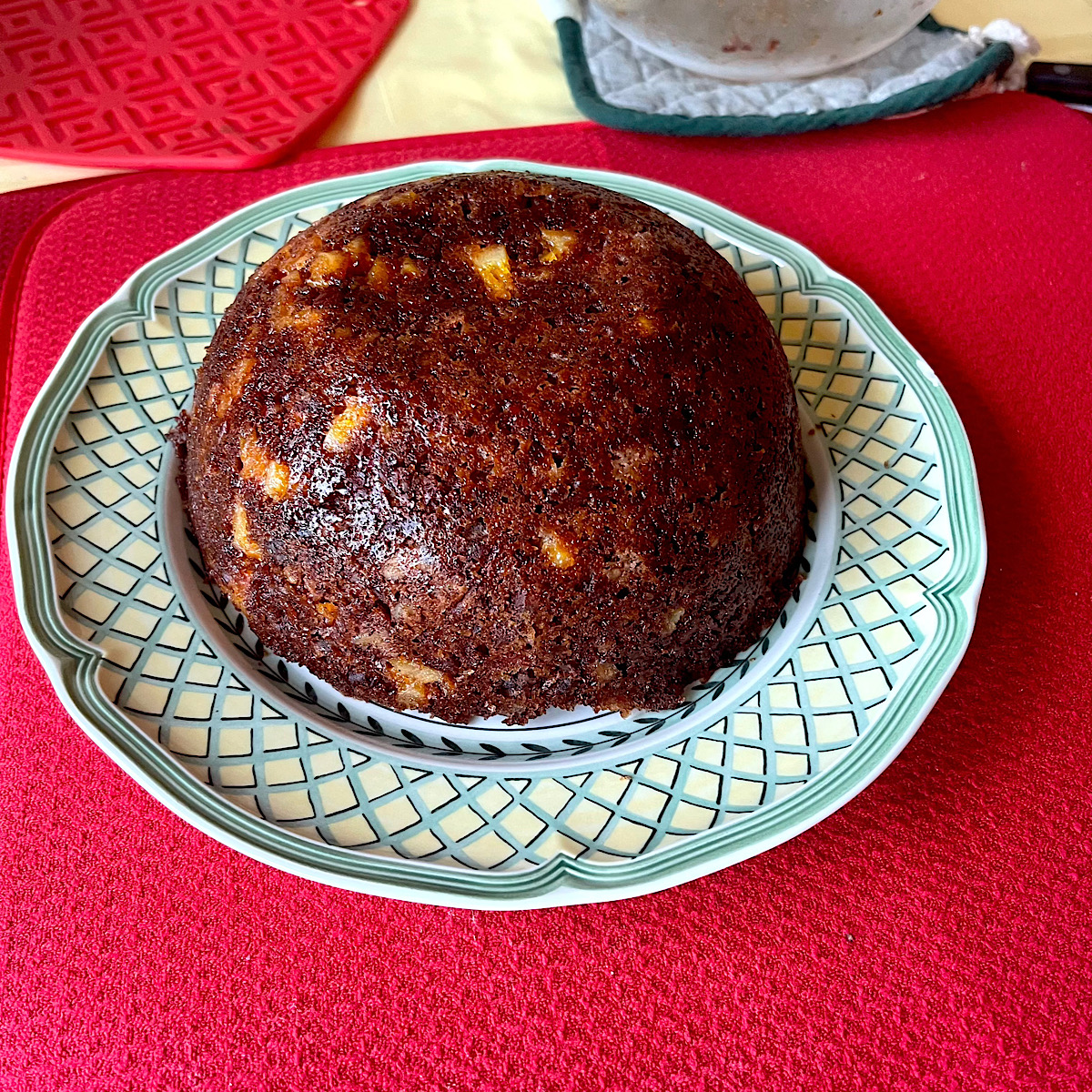
Specifics on How to Steam the Pudding
- When you have decided on your pudding mold, get out a pot that is large enough for the mold to fit inside, and tall enough that you have an inch or two from the top of the mold to the top of the pot. A canner with a lid works well, but it could be a tall stockpot or spaghetti pot. Make sure you have a lid that fits over the pot.
- I used a metal trivet on the bottom of the pot to set the mold on and keep it off the bottom of the pot.
- Place a penny in the bottom of the pot (some people use glass marbles). If your water level gets too low while the pudding is steaming away on the stove, the penny or the marbles will start banging around and alert you to the need to add more water.
- Set the prepared mold on the trivet in the stockpot and add enough water to the pan that it comes halfway up the mold. If you fill it too high the water might boil into the mold, so just 1/2 way up. Cover the pot and turn the heat to high or medium high until the water comes to a steady, gentle boil.
- Once it comes to a boil, turn the heat down to medium low so that the water stays at a strong simmer. Turn a timer on to 30 minutes to check the water level.
- The pudding will need to steam for about 2 1/2 hours. Check the water level every 30 minutes, using a timer to remind you. You don’t want to burn the bottom of your pot.
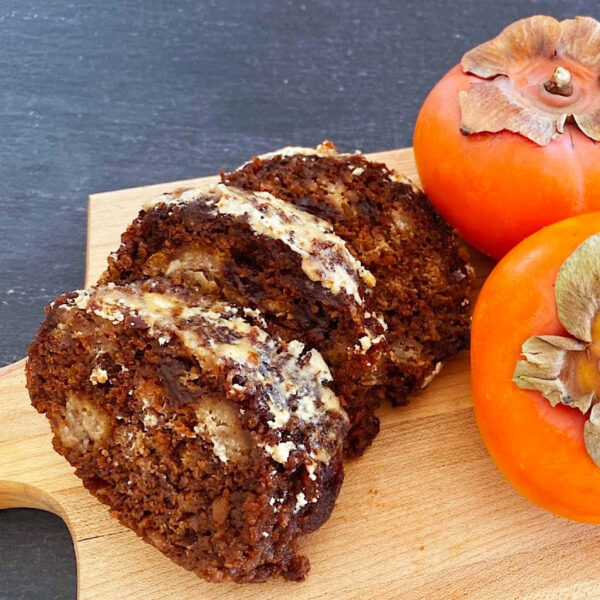
How to Get the Pudding out of the mold
If you have thoroughly buttered your mold, and if you have steamed it for at least 2 1/2 hours, it should come out of the mold fairly easily.
Here are the steps and tips to unmolding:
- After the 2 1/2 hour steaming process is over, remove the pudding from the heat. Don’t worry if you go 10-20 minutes longer than the 2 1/2 hours. The cake will still be rich and moist. Just don’t shorten the time or it might not be fully cooked in the middle.
- Let the pudding sit for about 10 minutes. Take the lid off and let it sit for another 10 minutes.
- Take a blunt knife and slide it around the edges of the cake where it meets the sides of the mold. Don’t forget to use the knife to loosen the inside hole part of the bundt cake also.
- Find a serving plate that is flat and larger than the mold. Place it on top of the mold and flip over. Tap with a spoon and lift the mold away. If it doesn’t come out readily, repeat step 3.
It might look a little wet at first, but it will dry out more as it cools and the steam comes out.
Storing and Freezing a Steamed Pudding
When it reaches room temperature, either keep it covered on the countertop for several days until ready to serve, or wrap it in plastic wrap and store in the refrigerator for up to 10 days.
It also freezes beautifully.
How to Serve
English steamed puddings are typically served with some sort of sauce or whipped cream. The “hard sauce” is another British term for a sweet sugar and butter sauce.
The sauce is not actually hard at all, but more like frosting. I found most of these sauces to be overly sweet and therefore I prefer whipped cream. However adding Grand Marnier or brandy to the hard sauce balances the sweetness. I did leave a recipe for a classic hard sauce in the recipe notes below.
It’s traditional to sprinkle a little bit of powdered sugar on top and place a sprig of holly if you are serving this at Christmas time.
Now if you really want to take it over the top at your gathering, you can flame it. The steamed pudding is on the table, out of the mold and you pour some brandy over the top and light it on fire. Quite dramatic!!!
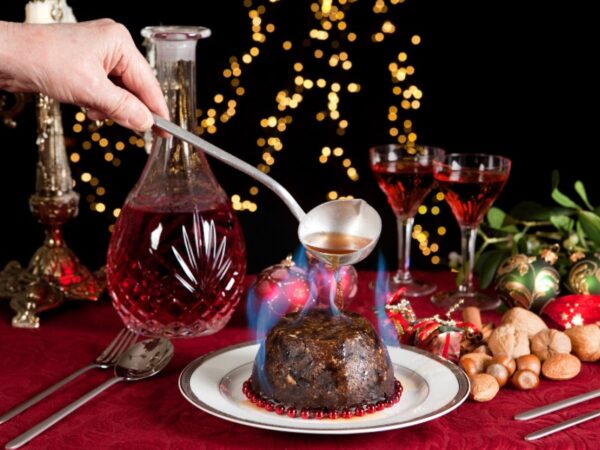
Frequently Asked Questions
Yes, it freezes really well. Wrap it in several layers of plastic wrap and it will freeze for several months. When you are ready to defrost it, pull it out of the freezer, but leave it wrapped and sitting at room temperature so that your cake or pudding will not become soggy. Once it’s at room temperature then you can remove the plastic wrap and serve it.
There are basically two types of persimmons. The Fuyu persimmon is usually eaten raw and is fairly firm. The Hachiya persimmon is only sweet when it’e very ripe and very soft.
Many people use the Hachiya persimmons when they are ripe or over-ripe because they puree easily. We only had the Fuyu persimmon available but once peeled and chopped it was easy to puree, and it was sweet and wonderful.
Other British Pudding Recipes:
This English Summer Pudding (with blueberries, raspberries and currants) is an easy pudding that I make in the summer. While not steamed, it also involves a “mold” that you can easily make with a large bowl.

Like this recipe? It helps me out greatly if you leave a 5-star 🌟🌟🌟🌟🌟rating in the recipe card below and maybe even leave me a quick comment too!
Persimmon Steamed Pudding
Equipment
- Pudding mold or 12-cup capacity bundt pan or glass mixing bowl
- 2 bowls, one small and one large for mixing ingredients
- auminum foil
- Large, tall stockpot or canner with cover
- Food processor or use your hands!
Ingredients
- ½ cup wheat flour or use 1 cup of all-purpose flour in total
- ½ cup all-purpose flour
- 1 teaspoon cinnamon
- ¼ teaspoon salt
- ½ teaspoon nutmeg freshly grated with a microplane
- 1 cup sugar
- 1 stick butter (1/2 cup) melted
- 3 persimmons fully ripened (fairly soft)
- 2 teaspoons baking soda dissolved in 2 teaspoons warm water
- 2 tablespoons brandy optional
- 1 teaspoon vanilla extract
- 2 eggs lightly beaten
- 1 ½ cup chopped candied orange slices can use any dried fruit or rasins
- 1 ½ cups walnuts or pecans finely chopped
Instructions
- In a bowl stir together the flour, cinnamon, salt and nutmeg.1/2 cup wheat flour, 1/2 cup all-purpose flour, 1 teaspoon cinnamon, 1/4 teaspoon salt, 1/2 teaspoon nutmeg
- In another bowl thoroughly mix together the sugar with the melted butter. Combine the flour mixture with the butter mixture and stir well.1 cup sugar, 1 stick butter (1/2 cup)
- Remove blossom end of persimmons and cut them into quarters (if using Fuyu persimmons, peel them first). Finely chop/mince the persimmon flesh or puree it in a blender.Add the persimmon pulp and the rest of the ingredients (baking soda through nuts) to the flour/sugar mixture in the bowl and stir together. Better yet, mix with your hands. This is your cake batter.3 persimmons, 2 teaspoons baking soda, 2 tablespoons brandy, 1 teaspoon vanilla extract, 2 eggs, 1 1/2 cup chopped candied orange slices, 1 1/2 cups walnuts or pecans
- Generously grease the pudding mold with butter or spray oil, making sure you get all the crevices of the mold, including the center hole of the bundt pan. Pour the batter into the mold two thirds of the way up. Cover tightly with aluminum foil, crimping the edges around the mold. I covered twice.
- In a stockpot or canner large enough to fit the mold with a couple inches left at the top, lower the mold inside the pot. If you have a metal trivet to place on bottom of pot before placing the mold in the pot, it will help ensure you don’t burn the bottom of the pot. Add enough water to the pot to bring the water level up to 1/2 of the sides of the mold. Add a penny or glass marbles to the pot if you think you will forget to check the water levels. Cover the pot and turn the burner on to medium high heat to bring the water to a low boil. Once the low boil is achieved, lower the heat to medium or medium-low to keep the water at a low simmer (or gentle boil). Once you reach the boil/simmer, start timing your cooking. You want to keep the water simmering for 2 1⁄2 hours. Keep checking the water level every 30 minutes (set a timer).
- After 2 1⁄2 hours, turn off the heat and remove the mold from the boiling water. Let it set at room temperature for about 10 minutes before removing the aluminum foil. Remove the foil and let the pudding set for an additional 10- 15 minutes before “unmolding” it.Slide a blunt knife between the cake and the sides and center parts of the mold to loosen it. Find a serving plate that is slightly larger than the base of the mold and place it on top of the mold (where the foil was before). Flip the plate over and gently tap the mold with a spoon to further loosen. Lift the mold away from the cake and say Ahhhh.
- Once the pudding is cooled to room temperature, you can leave it on the counter (covered) if you plan to serve it within a couple of days. You can also wrap it in plastic wrap and store in the refrigerator for up to 10 days. This steamed pudding also freezes very nicely. Simply wrap well and freeze up to 6 months.Serve the pudding at room temperature. It is often served with a hard sauce (see notes) or whipped cream. Some brave people will pour brandy on top of it at the table and light on fire. This is not necessary however. Steamed pudding is a showstopper with or without flames!
Video
Notes
- Beat butter in mixer with paddle attachment until fluffy. Add powdered sugar gradually until incorporated, scraping sides of the bowl as you go. Add brandy and briefly use processor to blend it together.
- Drizzle over steamed pudding, or keep in the fridge (it will last for days covered in plastic wrap) until you need it.
- The hard sauce will harden in the fridge, so be sure to remove it at least a couple of hours before you want to serve. Hard sauce should be smooth and easily spooned onto desserts.
Nutrition
Online Diet/Health Coaching:
Although I am not currently taking clients for diet & health coaching, I was a coach for many years with the online service called coach.me. It is a great platform for all kinds of coaching – anything from specific diets, writing a blog, getting up early, or getting rid of that pesky procrastination.
There are some wonderful coaches and the testimonials will tell you what you need to know. Contact me at [email protected] to get a referral to some of the tested, experienced online coaches on Coach.me.

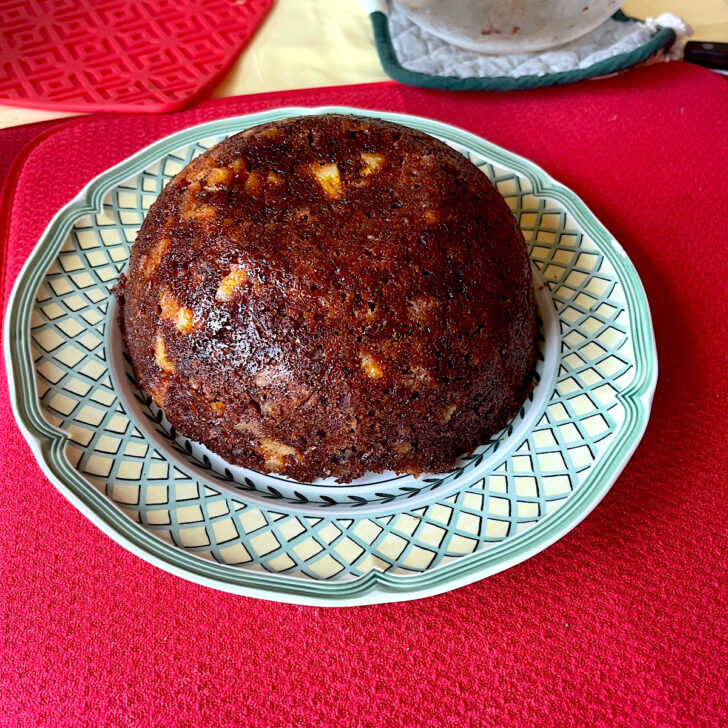

Your recipe looks wonderful and I’d like to try it, but I have no access to persimmons. What other fruit could I substitute? I have had considerable success enclosing my baking pan or pudding bowl in an oven cooking bag in addition to covering it with aluminum foil when steaming. Really keeps the moisture out.
Virginia, While I have not made the steamed pudding with any fruit besides persimmons, I think just about any fruit would work. I would try plums with this recipe as they are about the same size and texture as the persimmons. The steamed puddings are quite popular in England and this website has a number of recipes for steamed puddings with different fruits: https://www.olivemagazine.com/. They even have savory steamed pudding recipes!
Question about using a bundt pan instead of a pudding mold or bowl – when you say to cover the top tightly with foil, does that mean I need to tuck the foil down into the middle, following the “donut” shape of the bundt, or can I just put one large sheet across the whole thing and secure it on the outside? I can’t figure out if the hole in the middle of the bundt will cause a problem if I just cover the whole thing like I would if I were cooking it in a bowl.
I hope this question makes sense! Thank you!
Thanks for the question Jessica. Just put the large sheet across the whole thing and secure it on the outside and you should be good to go. I remember that it stuck a little bit trying to get it out along the inside of the hole so make sure that part is oiled. The video on youtube is helpful for getting it unstuck, so watch the youtube video and forward to the end of it to get a better idea.